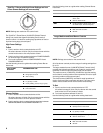
7
COOKTOP USE
Cookware
IMPORTANT: Do not leave empty cookware on a hot surface
cooking area, element or surface burner.
Ideal cookware should have a flat bottom, straight sides, a well-
fitting lid and the material should be of medium-to-heavy
thickness.
Rough finishes may scratch the cooktop. Aluminum and copper
may be used as a core or base in cookware. However, when used
as a base it can leave permanent marks on the cooktop or grates.
Cookware material is a factor in how quickly and evenly heat is
transferred, which affects cooking results. A nonstick finish has
the same characteristics as its base material. For example,
aluminum cookware with a nonstick finish will take on the
properties of aluminum.
Griddles with nonstick surfaces should not be used under the
broiler.
Use the following chart as a guide for cookware material
characteristics.
Home Canning
When canning for long periods, alternate the use of surface
cooking areas, elements or surface burners between batches.
This allows time for the most recently used areas to cool.
■ Center the canner on the grate or largest surface cooking
area or element. Canners should not extend more than ½"
(1.25 cm) outside the cooking area.
■ Do not place canner on two surface cooking areas, elements
or surface burners at the same time.
■ For more information, contact your local U.S. Government
Agricultural Department Extension Office. In Canada, contact
Agriculture Canada. Companies that manufacture home
canning products can also offer assistance.
Cooktop Controls
IMPORTANT: Your cooktop is factory-set for use with natural
gas. If you wish to use L.P. Gas, an L.P. Gas Conversion Kit is
included with your new range. Models with the TripleTier™ Flame
Burner will include a TripleTier™ L.P. Gas Conversion Kit and a kit
for standard ranges. See “Installation Instructions” for details on
making this conversion.
Electric igniters automatically light the surface burners when
control knobs are turned to LITE.
Before setting a control knob, place filled cookware on the grate.
Do not operate a burner while using empty cookware or without
any cookware on the grate.
NOTE: Visually check that the burner has lit. If the burner does
not ignite, listen for the clicking sound. If you do not hear the
igniter click, TURN THE BURNER OFF. Check for a tripped circuit
breaker or blown fuse.
Check that the control knob is pressed completely down on the
valve shaft. If the spark igniter still does not operate, call a trained
repair specialist.
Proper grounding and polarity are necessary for correct operation
of the electric ignition system. If the wall receptacle does not
provide correct polarity, the igniters will become grounded and
occasionally click, even after the burner has ignited. Contact a
trained repair specialist to check the wall receptacle to see
whether it is wired with the correct polarity.
Power failure
In case of prolonged power failure, the surface burners can be
lighted manually. Hold a lit match near a burner and turn knob
counterclockwise to LITE. After burner lights, turn knob to
setting.
COOKWARE CHARACTERISTICS
Aluminum ■ Heats quickly and evenly.
■ Suitable for all types of cooking.
■ Medium or heavy thickness is best for
most cooking tasks.
Cast iron
■ Heats slowly and evenly.
■ Good for browning and frying.
■ Maintains heat for slow cooking.
Ceramic or Ceramic
glass
■ Follow manufacturer’s instructions.
■ Heats slowly, but unevenly.
■ Ideal results on low to medium heat
settings.
Copper
■ Heats very quickly and evenly.
Earthenware
■ Follow manufacturer’s instructions.
■ Use on low heat settings.
Porcelain enamel-
on-steel or cast iron
■ See stainless steel or cast iron.
Stainless steel
■ Heats quickly, but unevenly.
■ A core or base of aluminum or copper on
stainless steel provides even heating.
WARNING
Fire Hazard
Do not let the burner flame extend beyond the
edge of the pan.
Turn off all controls when not cooking.
Failure to follow these instructions can result in
death or fire.
REMEMBER: When cooktop is in use, the entire
cooktop area may become hot.


















